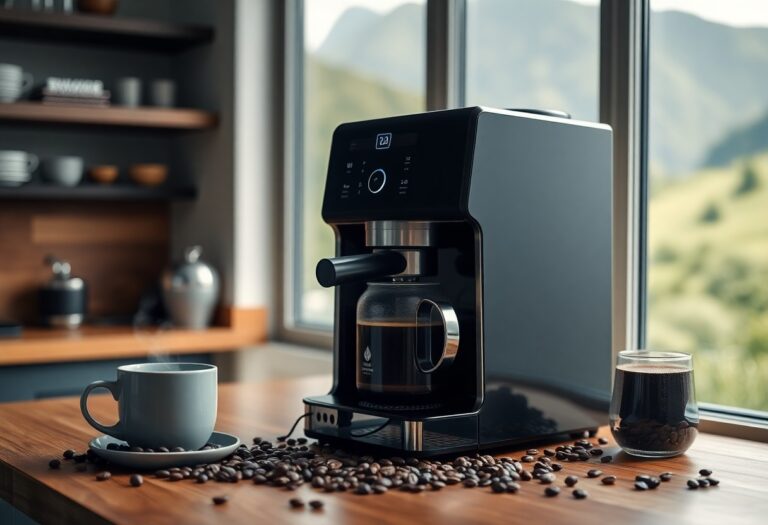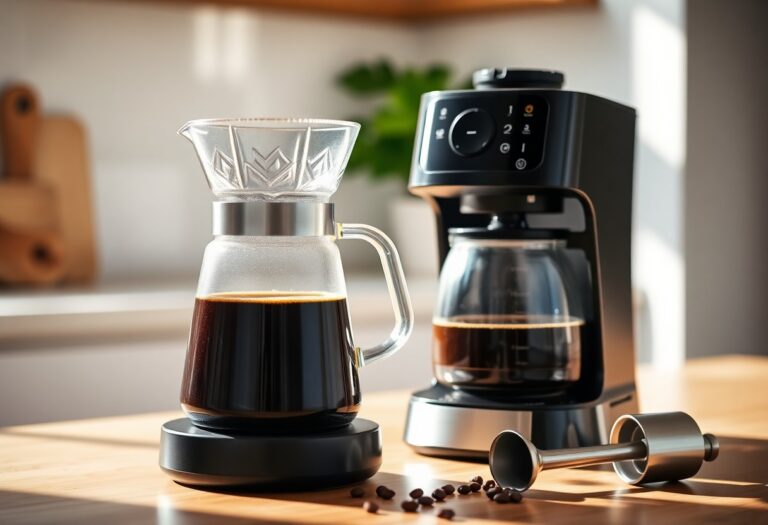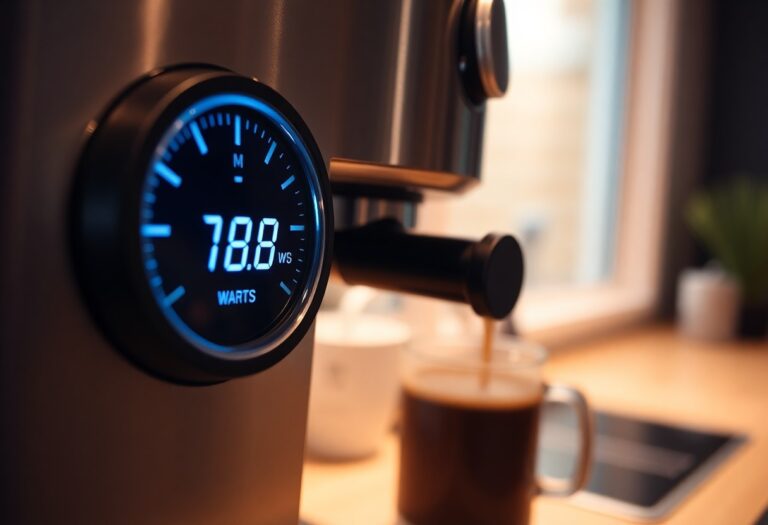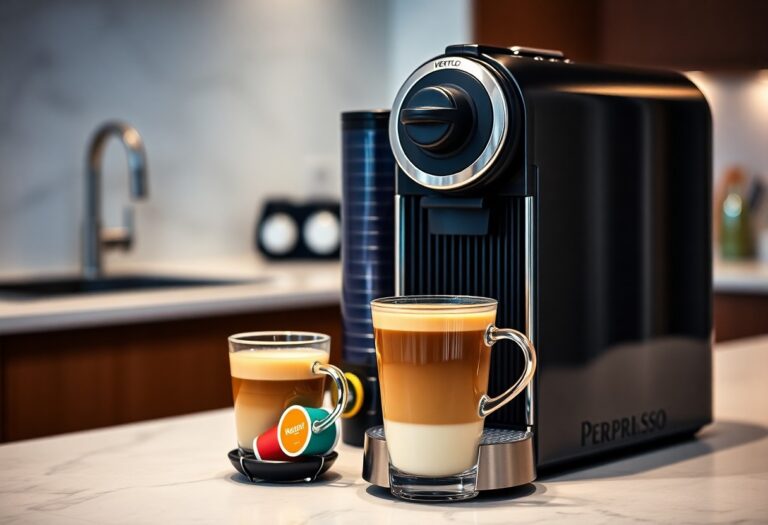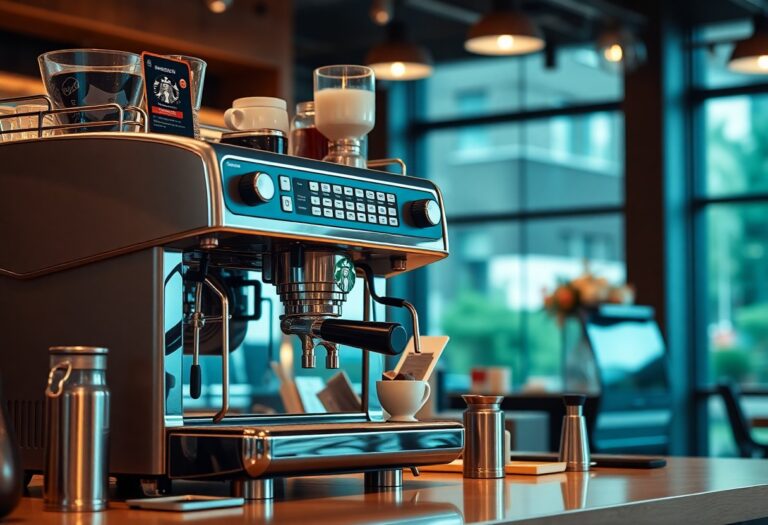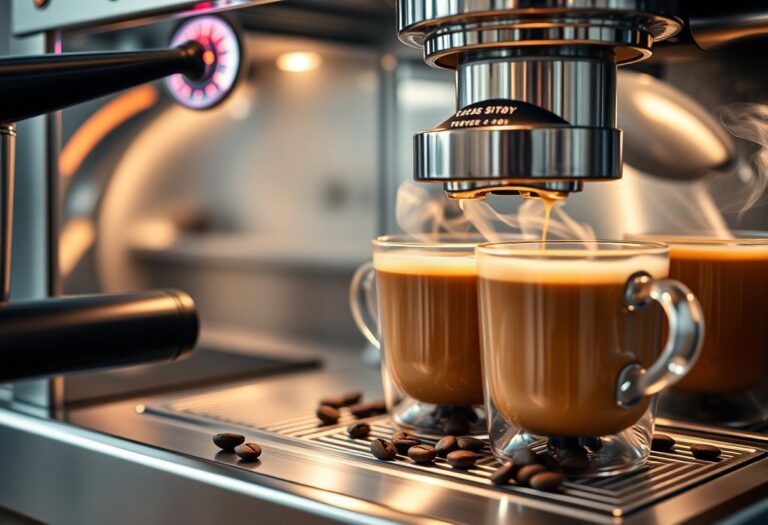What is That a Coffee Machine – Identification Guide
There’s a world of coffee machines out there, and identifying the right one for your needs can be overwhelming. In this guide, you’ll discover how to recognize different types of coffee machines, from espresso makers to drip coffee brewers, along with their unique features and benefits. Understanding these machines not only enhances your brewing experience but can also prevent potential mishaps. Whether you’re a beginner or a seasoned coffee enthusiast, this guide will equip you with the knowledge to make informed decisions about your coffee machine.
Key Takeaways:
- Different types of coffee machines include espresso machines, drip coffee makers, single-serve pod machines, and French presses, each offering unique brewing methods.
- Understanding the components of a coffee machine, such as the water reservoir, brew basket, and heating element, can aid in identifying and troubleshooting issues.
- Some machines are designed for specific coffee styles—knowing whether you want espresso, filtered coffee, or specialty drinks helps narrow down options.
- Features like programmability, built-in grinders, and milk frothers enhance user experience but can add complexity in identifying the right machine.
- Maintenance and cleaning requirements differ among machines, impacting usability and longevity; regular upkeep is necessary for optimal performance.
Decoding the Coffee Machine Hierarchy
Understanding the hierarchy of coffee machines helps you navigate the options available, from basic brewers to commercial giants. Machines are generally categorized based on their features, capabilities, and intended use, ensuring you can find an option that perfectly aligns with your coffee-making ambitions.
The Home Brews: Entry-Level Machines
Entry-level machines are perfect for beginners, offering simplicity and affordability. These basic brewers often come with straightforward settings, allowing you to enjoy your coffee without overwhelming options. A popular choice in this category is the drip coffee maker, which provides consistent results with minimal effort.
The Intermediate League: Mid-Range Marvels
Mid-range machines combine advanced features with usability, making them an excellent choice for enthusiasts looking to elevate their brewing. Models like semi-automatic espresso machines fall into this category. They give you greater control over the brewing process, allowing you to experiment with grind sizes and brew times for a more tailored cup.
Going beyond basic functionality, mid-range models often include frothers and programmable settings to customize your drinks. Investing in this tier provides a balance between affordability and quality, making it accessible for coffee lovers wanting to explore more complex brewing methods without breaking the bank. Brands like Breville and DeLonghi are excellent representatives in this segment, offering machines that feature quality construction and reliable performance.
Professional Powerhouses: Commercial Equipment
For those in the café business or serious about their coffee craft, commercial machines are a game changer. Built to handle high volumes, these machines are engineered for durability and consistency, often featuring multiple group heads and advanced technology to ensure perfect extractions every time.
Commercial equipment, such as the La Marzocco Linea or the Nuova Simonelli Aurelia, caters to demanding environments, boasting powerful boilers, rapid heat-up times, and precision temperature control. These machines not only enhance workflow efficiency, but enable you to provide a high-quality coffee experience that satisfies discerning customers. Beyond just performance, investing in commercial-grade equipment can elevate your brand’s reputation, showcasing a commitment to quality and craftsmanship in every cup.
Component Breakdown: What Lies Beneath the Surface
Understanding the components of your coffee machine is imperative for optimizing your brewing experience. From the grinder mechanism to the heating system, each part plays a pivotal role in achieving the perfect cup of coffee. By exploring into the intricacies of these components, you can appreciate not just the functionality but also how they contribute to flavor, temperature, and overall performance.
The Role of Grinders: Blade vs. Burr
Grinders can significantly impact the quality of your coffee, with two primary types: blade and burr grinders. Blade grinders chop beans randomly, often resulting in uneven grind sizes and over-extraction. In contrast, burr grinders crush beans between two abrasive surfaces, providing a consistent grind that enhances flavor extraction and brewing precision.
Heating Systems: Coils, Boilers, and PID Controllers
Heating systems in coffee machines can vary widely, with options like coils, boilers, and PID controllers each offering distinct advantages. Coils heat water quickly but may struggle with temperature stability, while boilers provide a constant supply of hot water, ideal for espresso. PID controllers enhance temperature accuracy, ensuring optimal extraction for your coffee.
PID (Proportional-Integral-Derivative) controllers have revolutionized brewing by providing precise temperature management. With the ability to adjust water temperature in real-time, these controllers prevent fluctuations during the brewing cycle, which directly impacts flavor extraction. By maintaining stable temperatures, you experience a more balanced and flavorful cup of coffee every time you brew.
Water Delivery Systems: Pump Types Explained
Your coffee machine’s water delivery system is vital for ensuring proper extraction, with several pump types available, including vibratory, rotary, and solenoid pumps. Vibratory pumps are compact and good for home machines, while rotary pumps deliver consistent pressure, ideal for commercial environments. Understanding the differences can help you select a machine tailored to your needs.
| Pump Type | Description |
| Vibratory | Compact, suitable for home machines. |
| Rotary | Consistent pressure, ideal for commercial use. |
| Solenoid | Used for specific brew methods, affordable. |
| Pressure | Deliver optimal brewing conditions. |
| Flow Rate | Impacts brewing time and extraction. |
Selecting the right pump for your coffee machine ensures optimal extraction and brewing efficiency. A vibratory pump may be handy for smaller setups, while rotary pumps provide the pressure needed for a consistent espresso brew. After considering your brewing style, you can make an informed decision to enhance your coffee experience.
- Vibratory pump: Compact, home machines
- Rotary pump: Consistent pressure, commercial
- Solenoid pump: Affordable, specific methods
- Pressure control: Optimal conditions
- Flow rate: Impacts extraction time
With a solid understanding of these systems, you can refine your coffee-making process and ensure you’re getting the best flavor out of your beans. After you’ve mastered your equipment, you’ll appreciate the nuances in every cup you brew.
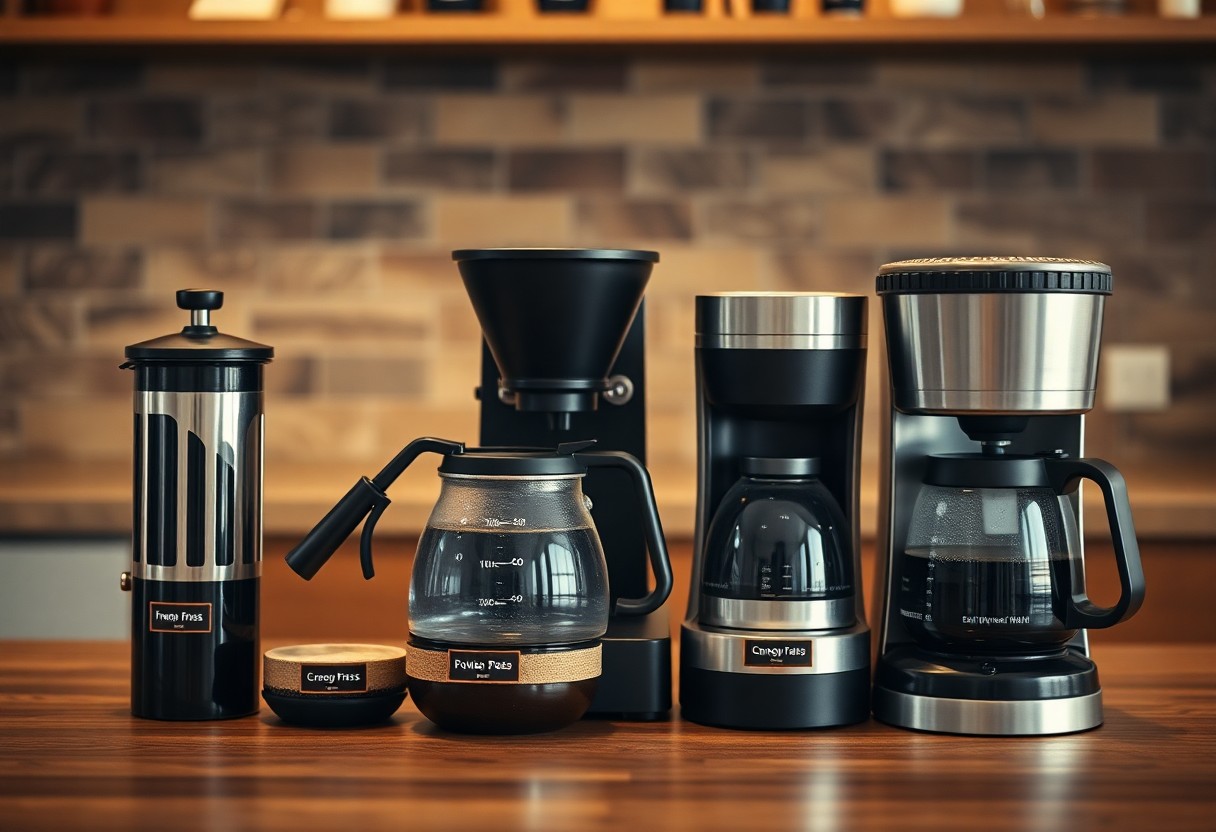
Brewing Methods: A Comparative Analysis
| Method | Description |
| Espresso | A concentrated coffee brewed by forcing hot water through finely-ground coffee. |
| Drip | A method where water drips through coffee grounds in a filter, producing a lighter brew. |
| French Press | Coarse coffee grounds steeped in hot water and separated by pressing down a metal or plastic plunger. |
| AeroPress | A device using air pressure to push hot water through coffee grounds for a quick, intense cup. |
| Pour Over | Manual brewing that involves pouring water over coffee grounds in a filter, allowing gravity to extract flavors. |
Espresso vs. Drip: The Fundamental Differences
Espresso and drip coffee represent the two poles of coffee brewing, differing mainly in extraction method and flavor profile. Espresso is characterized by its intense, concentrated flavor and thick crema, achieved through high-pressure water extraction. Drip coffee, on the other hand, provides a milder, smoother taste, as water extracts flavors slowly and gently over time. Your choice between these methods often reflects your taste preferences and caffeine needs.
Specialty Techniques: French Press, AeroPress, and Pour Over
Each of these specialty techniques offers a unique approach to crafting coffee. The French Press steeps grounds directly, resulting in a rich, full-bodied flavor. The AeroPress, known for its speed, uses air pressure to generate a clean and strong cup. Pour over, a more manual method, highlights the coffee’s subtleties, allowing for precise control over the brewing process.
The French Press is celebrated for its robust brew, thanks to the immersion method that extracts oils and flavors more intensely. Aeropress offers versatility and speed, making it a favorite for busy mornings or travel. Pour over, on the other hand, allows for meticulous control over water temperature and flow rate, letting you explore the unique notes of various coffee beans. Each technique showcases different qualities, enriching your coffee experience and highlighting the author’s craftsmanship.
Automated Wonders: Single-Serve Machines and Their Mechanics
Single-serve machines, including popular brands like Keurig or Nespresso, revolutionize the way you brew coffee by providing quick, convenient cups from pre-packaged pods. This technology simplifies the brewing process, making it accessible even for those with limited time or experience.
These machines utilize a pod-based system that contains coffee grounds sealed for freshness. When you press a button, the machine pierces the pod and forces hot water through it. The result is a consistent cup of coffee with minimal effort. However, you may want to explore various pod options to find a flavor that suits your taste, as these machines tend to limit the type of coffee you can enjoy. For true aficionados, they may lack the depth of flavor obtained through more traditional brewing methods.
Signals of Quality: Assessing Machine Performance
When evaluating the performance of your coffee machine, specific indicators can affirm its quality. Key signals include the brew temperature consistency, extraction time, and overall cup quality. Machines with precise temperature controls often deliver better flavors. For an in-depth understanding of different coffee machines and their performance, discover which type of coffee machine is right for you.
Taste Test: Analyzing Brew Quality
Assessing the brew quality of your coffee machine starts with taste. A well-functioning machine extracts the right flavors, resulting in a balanced cup. Look for rich aroma, smooth texture, and visible crema in espresso machines. If your brew tastes overly bitter or weak, reevaluate your machine’s performance.
Durability and Maintenance: Long-Term Factors
Durability plays a significant role in your coffee machine’s longevity. Investing in high-quality materials can make a difference, as sturdier options tend to withstand wear and tear. Regular maintenance is equally important – descaling, cleaning filters, and replacing worn parts keeps your machine in optimal working condition, ensuring consistent performance.
- Durability enhances long-term quality.
- Maintenance ensures consistent performance over time.
- Investment in premium materials pays off.
- Assume that a neglected machine will yield poor results.
In-depth examination of durability showcases the materials used in coffee machines, such as stainless steel versus plastic. Stainless steel units may cost more but generally handle heat retention better and resist damage well. Regular maintenance routines, including descaling procedures and cleaning, are vital for long-term performance, particularly in machines that produce steam or espresso. Assume that investing time in these practices ensures a longer lifespan for your coffee maker.
- Materials impact durability directly.
- Cleaning prolongs machine life.
- Maintenance fixes minor issues before they escalate.
- Assume that overlooking maintenance shortens your machine’s lifespan.
User Experience: Ease of Use and Design
Your coffee machine should offer an intuitive and user-friendly experience. Quality machines often feature programmable settings, easy-to-read displays, and efficient interfaces. Machines designed with consideration for user experience make brewing coffee a delightful and uncomplicated process.
A quality coffee machine blends functionality with aesthetic design. Ease of use is enhanced by thoughtfully placed controls, efficient workflows, and visual indicators that alert you to important tasks like refilling water or adjusting grind size. A machine that prioritizes user experience not only looks good on your kitchen counter but also enhances your daily routine, allowing you to brew your favorite coffee with minimal effort.
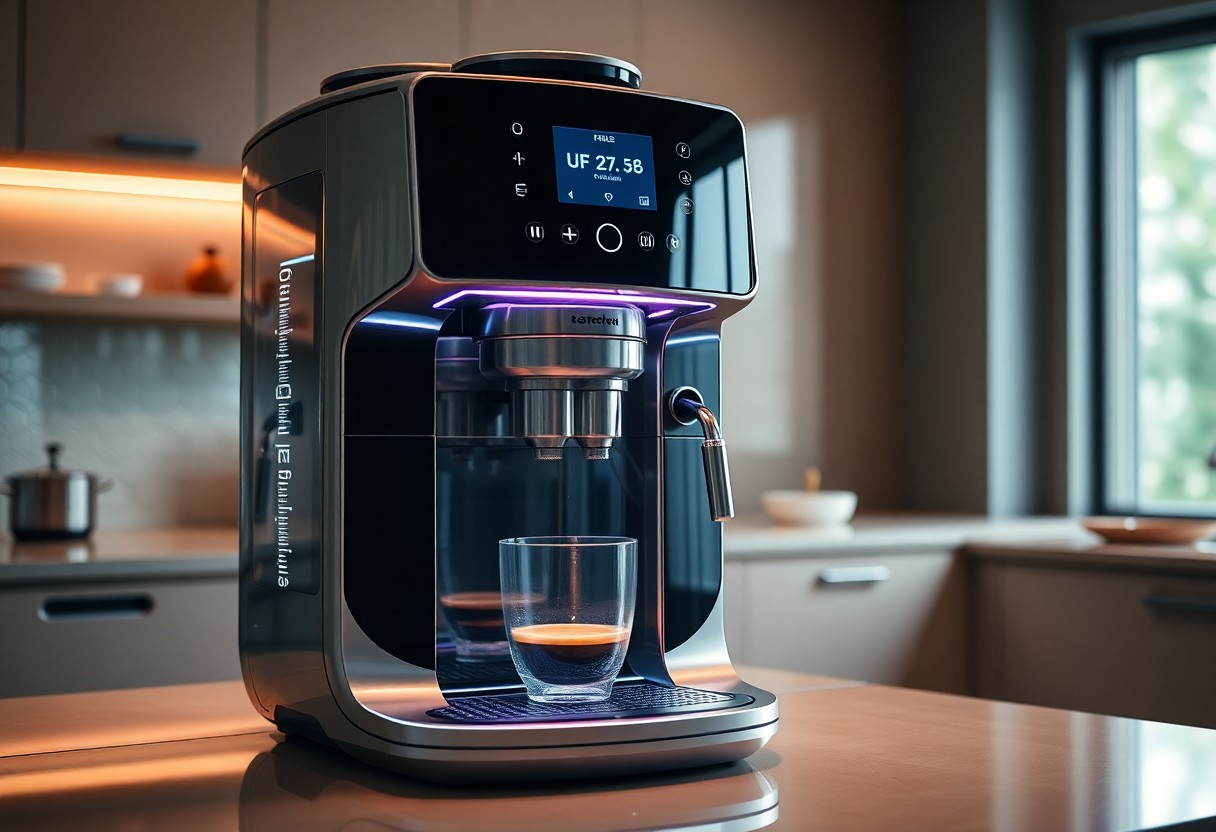
The Future of Coffee Technology: Innovations on the Horizon
Exciting advancements in coffee technology promise to enhance your brewing experience. From machines that can adapt to individual taste preferences to appliances that streamline the entire process, innovations are reshaping the coffee landscape. Automated systems now boast features like precise temperature control and integrated grinding mechanisms that elevate flavor extraction, ensuring every cup is as enjoyable as possible. The future of coffee machines is not just about brewing; it’s about personalizing and perfecting each sip.
Smart Machines: Integration with IoT
Your coffee experience is about to get smarter with the integration of Internet of Things (IoT) technology into coffee machines. Smart coffee makers allow you to control brewing settings remotely, receive maintenance alerts, and even reorder supplies automatically. Imagine starting your morning routine from bed by simply activating your machine via an app. As manufacturers continue to embrace connectivity, the potential for personalized brewing becomes limitless, ensuring your coffee is tailored precisely to your liking, anytime.
Sustainability Trends: Eco-Friendly Practices in Machine Design
As awareness of environmental issues grows, the coffee industry is responding through sustainable design practices. Modern machines are increasingly built using recycled materials and energy-efficient technologies that minimize carbon footprints. In addition, many brands are focusing on modular designs, allowing you to repair or upgrade parts rather than replacing entire machines. This shift not only reduces waste but also encourages a culture of sustainability among consumers, making your morning cup of coffee a little kinder to the planet.
Examining the sustainability trends in coffee machine design, you’ll find manufacturers prioritizing eco-friendly innovations like biodegradable components, energy-saving modes, and recyclable packaging. For instance, some machines utilize materials sourced from renewable resources, thus lowering their ecological impact. Brands are also investing in energy-efficient heating systems that cut energy consumption by up to 40%. Furthermore, encouraging a longer lifespan for machines through repairable parts and easy upgrades resonates with environmentally conscious consumers. Opting for these sustainable coffee machines not only enhances your brewing experience but also aligns with a growing commitment to protecting our planet.
Summing up
From above, you now have a comprehensive understanding of different coffee machine types and their specific features. By identifying your brewing preferences and needs, you can select the right coffee machine that aligns with your lifestyle and taste. Whether you prefer espresso, drip coffee, or single-serve options, knowing the distinctions enables you to make an informed choice. This guide empowers you to elevate your coffee experience, ensuring you enjoy every cup to its fullest.
FAQ
Q: What are the main types of coffee machines discussed in the identification guide?
A: The identification guide outlines several main types of coffee machines, including drip coffee makers, espresso machines, single-serve pod machines, French presses, and pour-over setups. Each type is designed for specific brewing methods and offers different features catering to various coffee preferences.
Q: How can I identify a drip coffee maker from other coffee machines?
A: A drip coffee maker typically features a water reservoir, a filter basket, and a carafe. To identify one, look for a machine that brews coffee by dripping hot water through coffee grounds held in a paper or metal filter. Most models also include a warming plate to keep the coffee hot after brewing.
Q: What key features should I look for in an espresso machine?
A: When identifying an espresso machine, look for features such as a portafilter, a steam wand for frothing milk, and a pump system that generates the necessary pressure for brewing. Many espresso machines also have a user interface for controlling settings like shot volume and temperature.
Q: How does a single-serve pod coffee machine differ from traditional brewing methods?
A: A single-serve pod coffee machine is designed to brew one cup of coffee at a time using pre-packaged coffee pods. Unlike traditional brewing methods that often require manual measuring and filtering, these machines simplify the process by allowing users to insert a pod, press a button, and enjoy their coffee in minutes.
Q: What are the benefits of using a French press compared to other coffee brewing methods?
A: The French press offers a unique brewing experience by allowing coffee grounds to steep directly in hot water, resulting in a fuller flavor and richer body. Its simplicity and absence of paper filters let more oils from the coffee grounds pass through, which many coffee enthusiasts appreciate. Additionally, it requires no electricity, making it a great option for travel or outdoor use.


